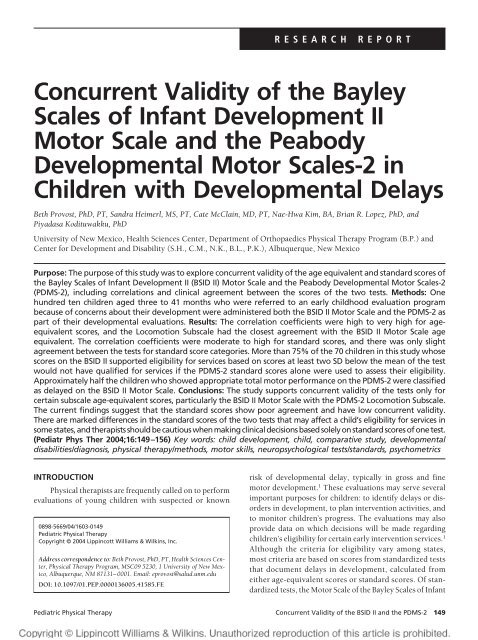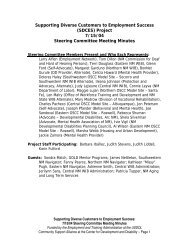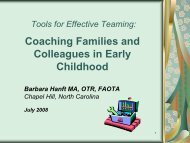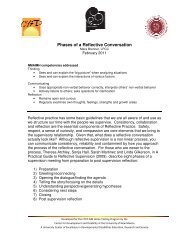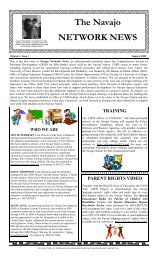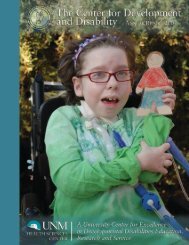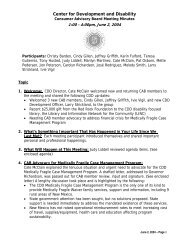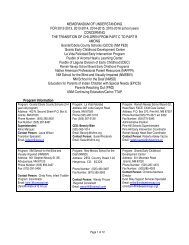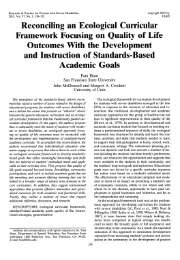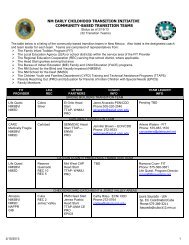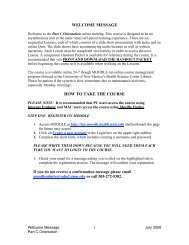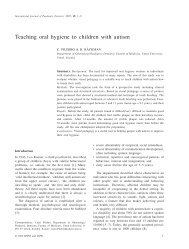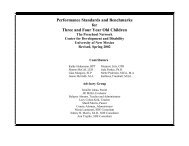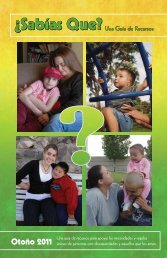Concurrent Validity of the Bayley Scales of Infant Development II ...
Concurrent Validity of the Bayley Scales of Infant Development II ...
Concurrent Validity of the Bayley Scales of Infant Development II ...
You also want an ePaper? Increase the reach of your titles
YUMPU automatically turns print PDFs into web optimized ePapers that Google loves.
RESEARCH REPORT<br />
<strong>Concurrent</strong> <strong>Validity</strong> <strong>of</strong> <strong>the</strong> <strong>Bayley</strong><br />
<strong>Scales</strong> <strong>of</strong> <strong>Infant</strong> <strong>Development</strong> <strong>II</strong><br />
Motor Scale and <strong>the</strong> Peabody<br />
<strong>Development</strong>al Motor <strong>Scales</strong>-2 in<br />
Children with <strong>Development</strong>al Delays<br />
Beth Provost, PhD, PT, Sandra Heimerl, MS, PT, Cate McClain, MD, PT, Nae-Hwa Kim, BA, Brian R. Lopez, PhD, and<br />
Piyadasa Kodituwakku, PhD<br />
University <strong>of</strong> New Mexico, Health Sciences Center, Department <strong>of</strong> Orthopaedics Physical Therapy Program (B.P.) and<br />
Center for <strong>Development</strong> and Disability (S.H., C.M., N.K., B.L., P.K.), Albuquerque, New Mexico<br />
Purpose: The purpose <strong>of</strong> this study was to explore concurrent validity <strong>of</strong> <strong>the</strong> age equivalent and standard scores <strong>of</strong><br />
<strong>the</strong> <strong>Bayley</strong> <strong>Scales</strong> <strong>of</strong> <strong>Infant</strong> <strong>Development</strong> <strong>II</strong> (BSID <strong>II</strong>) Motor Scale and <strong>the</strong> Peabody <strong>Development</strong>al Motor <strong>Scales</strong>-2<br />
(PDMS-2), including correlations and clinical agreement between <strong>the</strong> scores <strong>of</strong> <strong>the</strong> two tests. Methods: One<br />
hundred ten children aged three to 41 months who were referred to an early childhood evaluation program<br />
because <strong>of</strong> concerns about <strong>the</strong>ir development were administered both <strong>the</strong> BSID <strong>II</strong> Motor Scale and <strong>the</strong> PDMS-2 as<br />
part <strong>of</strong> <strong>the</strong>ir developmental evaluations. Results: The correlation coefficients were high to very high for ageequivalent<br />
scores, and <strong>the</strong> Locomotion Subscale had <strong>the</strong> closest agreement with <strong>the</strong> BSID <strong>II</strong> Motor Scale age<br />
equivalent. The correlation coefficients were moderate to high for standard scores, and <strong>the</strong>re was only slight<br />
agreement between <strong>the</strong> tests for standard score categories. More than 75% <strong>of</strong> <strong>the</strong> 70 children in this study whose<br />
scores on <strong>the</strong> BSID <strong>II</strong> supported eligibility for services based on scores at least two SD below <strong>the</strong> mean <strong>of</strong> <strong>the</strong> test<br />
would not have qualified for services if <strong>the</strong> PDMS-2 standard scores alone were used to assess <strong>the</strong>ir eligibility.<br />
Approximately half <strong>the</strong> children who showed appropriate total motor performance on <strong>the</strong> PDMS-2 were classified<br />
as delayed on <strong>the</strong> BSID <strong>II</strong> Motor Scale. Conclusions: The study supports concurrent validity <strong>of</strong> <strong>the</strong> tests only for<br />
certain subscale age-equivalent scores, particularly <strong>the</strong> BSID <strong>II</strong> Motor Scale with <strong>the</strong> PDMS-2 Locomotion Subscale.<br />
The current findings suggest that <strong>the</strong> standard scores show poor agreement and have low concurrent validity.<br />
There are marked differences in <strong>the</strong> standard scores <strong>of</strong> <strong>the</strong> two tests that may affect a child’s eligibility for services in<br />
some states, and <strong>the</strong>rapists should be cautious when making clinical decisions based solely on standard scores <strong>of</strong> one test.<br />
(Pediatr Phys Ther 2004;16:149–156) Key words: child development, child, comparative study, developmental<br />
disabilities/diagnosis, physical <strong>the</strong>rapy/methods, motor skills, neuropsychological tests/standards, psychometrics<br />
INTRODUCTION<br />
Physical <strong>the</strong>rapists are frequently called on to perform<br />
evaluations <strong>of</strong> young children with suspected or known<br />
0898-5669/04/1603-0149<br />
Pediatric Physical Therapy<br />
Copyright © 2004 Lippincott Williams & Wilkins, Inc.<br />
Address correspondence to: Beth Provost, PhD, PT, Health Sciences Center,<br />
Physical Therapy Program, MSC09 5230, 1 University <strong>of</strong> New Mexico,<br />
Albuquerque, NM 87131–0001. Email: eprovost@salud.unm.edu<br />
DOI: 10.1097/01.PEP.0000136005.41585.FE<br />
risk <strong>of</strong> developmental delay, typically in gross and fine<br />
motor development. 1 These evaluations may serve several<br />
important purposes for children: to identify delays or disorders<br />
in development, to plan intervention activities, and<br />
to monitor children’s progress. The evaluations may also<br />
provide data on which decisions will be made regarding<br />
children’s eligibility for certain early intervention services. 1<br />
Although <strong>the</strong> criteria for eligibility vary among states,<br />
most criteria are based on scores from standardized tests<br />
that document delays in development, calculated from<br />
ei<strong>the</strong>r age-equivalent scores or standard scores. Of standardized<br />
tests, <strong>the</strong> Motor Scale <strong>of</strong> <strong>the</strong> <strong>Bayley</strong> <strong>Scales</strong> <strong>of</strong> <strong>Infant</strong><br />
Pediatric Physical Therapy <strong>Concurrent</strong> <strong>Validity</strong> <strong>of</strong> <strong>the</strong> BSID <strong>II</strong> and <strong>the</strong> PDMS-2 149
<strong>Development</strong> <strong>II</strong> (BSID <strong>II</strong>) 2 and <strong>the</strong> Peabody <strong>Development</strong>al<br />
Motor <strong>Scales</strong>-2 (PDMS-2) 3 are two <strong>of</strong> <strong>the</strong> most commonly<br />
used discriminative measures in early intervention. 1<br />
Discriminative measures distinguish between children<br />
who have and do not have a particular characteristic. 4<br />
Physical <strong>the</strong>rapists must be able to distinguish between<br />
children who are developing typically in <strong>the</strong>ir motor performance<br />
and children who are developing atypically to<br />
reassure <strong>the</strong> parents <strong>of</strong> children who are typically developing<br />
and to monitor <strong>the</strong> development <strong>of</strong> children whose<br />
performance is different from that <strong>of</strong> <strong>the</strong>ir peers. Physical<br />
<strong>the</strong>rapists must also be able to distinguish between children<br />
who have significant motor delays and those with<br />
little or no delays to know which children may be eligible<br />
for intervention services in <strong>the</strong>ir community. Physical<br />
<strong>the</strong>rapists use <strong>the</strong>ir clinical judgment to make decisions<br />
about treatment needs, and <strong>the</strong>ir judgment is <strong>of</strong>ten assisted<br />
by results <strong>of</strong> standardized testing. If children’s age-equivalent<br />
scores are close to <strong>the</strong>ir chronological age (or age adjusted<br />
for prematurity if appropriate) and if <strong>the</strong>ir standard<br />
scores are appropriately close to <strong>the</strong> mean <strong>of</strong> <strong>the</strong> test, <strong>the</strong>n<br />
<strong>the</strong>rapists can be confident that children are developing<br />
appropriately for <strong>the</strong>ir age. If children’s age-equivalent<br />
scores are below <strong>the</strong>ir chronological age and if <strong>the</strong>ir standard<br />
scores are at least two SD below <strong>the</strong> mean <strong>of</strong> <strong>the</strong> test,<br />
<strong>the</strong>n <strong>the</strong>rapists can be confident that <strong>the</strong> children are not<br />
developing appropriately for <strong>the</strong>ir age and may benefit<br />
from services.<br />
Physical <strong>the</strong>rapists must choose tests that yield valid<br />
measurements <strong>of</strong> children’s motor performance for both<br />
age-equivalent scores and standard scores. Both <strong>the</strong> BSID <strong>II</strong><br />
Motor Scale and <strong>the</strong> PDMS-2 have appropriate psychometric<br />
properties <strong>of</strong> reliability and validity, are standardized<br />
and norm referenced, and measure motor skills in young<br />
children. 2,3 Differences, however, exist between <strong>the</strong> tests<br />
that may influence a <strong>the</strong>rapist’s choice <strong>of</strong> one test over <strong>the</strong><br />
o<strong>the</strong>r. Benefits <strong>of</strong> choosing <strong>the</strong> BSID <strong>II</strong> include compatibility<br />
with <strong>the</strong> BSID <strong>II</strong> Mental Scale, little need for equipment,<br />
and a combined score for both fine and gross motor areas.<br />
Benefits <strong>of</strong> choosing <strong>the</strong> PDMS-2 include separate scores<br />
for fine and gross motor skills and more test items in <strong>the</strong><br />
fine motor area. However, if a young child’s motor performance<br />
is evaluated with one or <strong>the</strong> o<strong>the</strong>r <strong>of</strong> <strong>the</strong>se tests, an<br />
important clinical question is raised: Are <strong>the</strong> child’s scores<br />
on <strong>the</strong>se two standardized tests similar and do <strong>the</strong>y lead to<br />
<strong>the</strong> same conclusions about his or her development being<br />
typical or delayed?<br />
<strong>Concurrent</strong> validity refers to <strong>the</strong> degree to which<br />
scores on a test are related to scores on ano<strong>the</strong>r test administered<br />
at <strong>the</strong> same time. 5 <strong>Concurrent</strong> validity has been<br />
reported for <strong>the</strong> original BSID Motor Scale and <strong>the</strong> original<br />
PDMS, 6 as well as for <strong>the</strong> BSID <strong>II</strong> Motor Scale and <strong>the</strong><br />
original PDMS. 7 Provost et al 7 found evidence for <strong>the</strong> concurrent<br />
validity <strong>of</strong> <strong>the</strong> BSID <strong>II</strong> Motor Scale and <strong>the</strong> PDMS<br />
for age-equivalent scores but not for standard scores in<br />
two-year-old Native American children. However, <strong>the</strong> authors<br />
stated that fur<strong>the</strong>r studies <strong>of</strong> <strong>the</strong> same relationship<br />
are needed with a larger sample from diverse ethnic back-<br />
grounds as well as with children who are at risk <strong>of</strong> or who<br />
have developmental delays. No concurrent validity studies<br />
have been published for <strong>the</strong> BSID <strong>II</strong> Motor Scale and <strong>the</strong><br />
PDMS-2.<br />
The purpose <strong>of</strong> this study was to explore correlations<br />
and clinical agreement between <strong>the</strong> age-equivalent and<br />
standard scores <strong>of</strong> <strong>the</strong> BSID <strong>II</strong> Motor Scale and <strong>the</strong> PDMS-2<br />
to address <strong>the</strong> following questions:<br />
1. Do age-equivalent scores on <strong>the</strong> BSID <strong>II</strong> Motor<br />
Scale correlate with age-equivalent scores on <strong>the</strong><br />
PDMS-2 Gross Motor Subscales and <strong>the</strong> PDMS-2<br />
Fine Motor Subscales?<br />
2. Do standard scores on <strong>the</strong> BSID <strong>II</strong> Motor Scale<br />
[Psychomotor <strong>Development</strong> Index (PDI)] correlate<br />
with standard scores on <strong>the</strong> PDMS-2 (Gross<br />
Motor Quotient, Fine Motor Quotient, and Total<br />
Motor Quotient)?<br />
3. Do age-equivalent scores and standard scores on<br />
<strong>the</strong> BSID <strong>II</strong> Motor Scale and <strong>the</strong> PDMS-2 agree for<br />
clinically important criteria?<br />
4. Do <strong>the</strong> BSID <strong>II</strong> Motor Scale and <strong>the</strong> PDMS-2 categorize<br />
children similarly for typical motor performance<br />
as well as for significant delays?<br />
METHODS<br />
Participants<br />
One hundred ten children (age: mean � 25.3 months,<br />
SD � 9.7, range � 3–41) were recruited from <strong>the</strong> University<br />
<strong>of</strong> New Mexico Health Sciences Center’s Center for<br />
<strong>Development</strong> and Disability Early Childhood Evaluation<br />
Program (ECEP) to participate in this study. <strong>Infant</strong>s and<br />
children throughout New Mexico are referred to <strong>the</strong> Center<br />
for <strong>Development</strong> and Disability ECEP for comprehensive<br />
interdisciplinary developmental evaluations. This<br />
well-established university program (University Center for<br />
Excellence in <strong>Development</strong>al Disabilities, Education, Research,<br />
and Service) has been serving young children and<br />
<strong>the</strong>ir families for more than 20 years, and <strong>the</strong> program<br />
evaluates approximately 300 children per year between <strong>the</strong><br />
ages <strong>of</strong> two and 48 months. Children are referred to <strong>the</strong><br />
program because <strong>the</strong>y are at risk <strong>of</strong> delay or have an established<br />
developmental delay and <strong>of</strong>ten have complex neurodevelopmental<br />
problems. The interdisciplinary team<br />
that sees each child is composed <strong>of</strong> a cognitive specialist<br />
who assesses cognitive, adaptive, and social/emotional development;<br />
a speech language pathologist who assesses<br />
speech and language development; a physical <strong>the</strong>rapist or<br />
an occupational <strong>the</strong>rapist who assesses gross and fine motor<br />
development and sensory processing abilities; and a<br />
pediatrician who conducts a medical examination. Standardized<br />
testing is routinely done to identify developmental<br />
levels and assess <strong>the</strong> quality <strong>of</strong> <strong>the</strong> child’s skills in <strong>the</strong><br />
various areas <strong>of</strong> development. The motor assessment routinely<br />
includes <strong>the</strong> administration <strong>of</strong> <strong>the</strong> BSID <strong>II</strong> Motor<br />
Scale and/or <strong>the</strong> PDMS-2.<br />
This study was approved by <strong>the</strong> University <strong>of</strong> New<br />
Mexico School <strong>of</strong> Medicine’s Human Research Review<br />
150 Provost et al Pediatric Physical Therapy
Committee. Each child’s parent or legal guardian was informed<br />
about <strong>the</strong> study and signed <strong>the</strong> consent form on <strong>the</strong><br />
day <strong>of</strong> <strong>the</strong> clinic visit. No compensation was provided for<br />
participants’ involvement in this study.<br />
The participants were 75 boys and 35 girls. The ethnicity<br />
<strong>of</strong> <strong>the</strong> sample was 35.5% white, 52.7% Hispanic,<br />
9.1% Native American, 1.8% Asian, and 0.9% African-<br />
American/Hispanic. Eighty-seven <strong>of</strong> <strong>the</strong> children (79%)<br />
had developmental delays in at least two areas <strong>of</strong> development<br />
(cognitive, speech, or motor delay), whereas 10 children<br />
(9%) had isolated speech delay and eight children<br />
(7%) had isolated motor delay. In addition to delays, 20 <strong>of</strong><br />
<strong>the</strong> children (18%) had a diagnosis <strong>of</strong> autism spectrum<br />
disorder/pervasive developmental disorder.<br />
Procedures<br />
One <strong>of</strong> two physical <strong>the</strong>rapists (B.P., S.H.) administered<br />
<strong>the</strong> BSID <strong>II</strong> Motor Scale and <strong>the</strong> PDMS-2 to each<br />
participating child as part <strong>of</strong> <strong>the</strong>ir routine ECEP evaluation.<br />
During <strong>the</strong> routine evaluation, <strong>the</strong> physical <strong>the</strong>rapist<br />
explained <strong>the</strong> study to <strong>the</strong> parent or legal guardian and<br />
answered any questions. If agreeable, <strong>the</strong> primary caregiver<br />
signed <strong>the</strong> consent form to have <strong>the</strong> child’s scores on <strong>the</strong><br />
two motor tests entered into <strong>the</strong> database. If parents elected<br />
not to participate, <strong>the</strong> child continued to receive <strong>the</strong> routine<br />
comprehensive evaluation. The two experienced pediatric<br />
physical <strong>the</strong>rapists involved in this study have performed<br />
developmental testing <strong>of</strong> young children for more<br />
than 25 years each. Interrater reliability was established<br />
between <strong>the</strong> two <strong>the</strong>rapists on six children. Three children<br />
were videotaped and <strong>the</strong>n scored from <strong>the</strong> videotape by<br />
both researchers. Three children were tested and scored in<br />
<strong>the</strong> clinic setting by one researcher while being observed<br />
and scored at <strong>the</strong> same time by <strong>the</strong> o<strong>the</strong>r researcher. Interrater<br />
agreement on <strong>the</strong> six children averaged 91% for <strong>the</strong><br />
PDMS-2 (range, 85–98%), and 96% for <strong>the</strong> BSID <strong>II</strong> Motor<br />
Scale (range, 88–100%).<br />
BSID. The BSID was revised to become <strong>the</strong> BSID <strong>II</strong> in<br />
1993, and normal values were redetermined on a sample <strong>of</strong><br />
1700 children between birth and 42 months. 2<br />
The BSID <strong>II</strong><br />
consists <strong>of</strong> a Mental Scale, a Motor Scale, and a Behavior<br />
Rating Scale and has been reviewed for psychometric<br />
strengths and limitations. 8 According to <strong>the</strong> manual, <strong>the</strong><br />
Motor Scale assesses degree <strong>of</strong> control <strong>of</strong> <strong>the</strong> body, coordination<br />
<strong>of</strong> <strong>the</strong> large muscles, finer manipulatory skills <strong>of</strong> <strong>the</strong><br />
hands and fingers, dynamic movement, dynamic praxis,<br />
postural imitation, and stereognosis. Raw scores on <strong>the</strong><br />
Motor Scale are converted to developmental age-equivalent<br />
scores as well as standard scores called <strong>the</strong> PDI scores. The<br />
mean standard score is 100 and <strong>the</strong> standard deviation<br />
(SD) is 15. The BSID <strong>II</strong> Motor Scale classifies performance<br />
based on whole-number SD from <strong>the</strong> mean, into categories<br />
<strong>of</strong> accelerated, within normal limits (WNL), mildly delayed,<br />
and significantly delayed.<br />
PDMS. The PDMS was revised to become <strong>the</strong><br />
PDMS-2 in 2000, and normal values were redetermined on<br />
a sample <strong>of</strong> 2003 children. 3 The PDMS-2 consists <strong>of</strong> six<br />
subtests: Reflexes (for children from birth through 11<br />
months), Stationary (ability to sustain control <strong>of</strong> body<br />
within its center <strong>of</strong> gravity), Locomotion (ability to move<br />
from one place to ano<strong>the</strong>r), Object Manipulation (ability to<br />
manipulate balls for children 12 months and older), Grasping<br />
(ability to use hands), and Visual-Motor Integration<br />
(ability to use visual perpetual skills to perform complex<br />
eye-hand coordination tasks). Raw scores on <strong>the</strong> PDMS-2<br />
are converted to age-equivalent scores for <strong>the</strong> subtests, percentiles,<br />
subtest standard scores, and composite standard<br />
scores called motor quotients. The Reflexes or Object Manipulation,<br />
Stationary, and Locomotion subtests contribute<br />
to <strong>the</strong> Gross Motor Quotient, and <strong>the</strong> Grasping and<br />
Visual-Motor Integration subtests contribute to <strong>the</strong> Fine<br />
Motor Quotient, and <strong>the</strong> Total Motor Quotient is formed<br />
by a combination <strong>of</strong> <strong>the</strong> results <strong>of</strong> <strong>the</strong> gross and fine motor<br />
subtests. Although <strong>the</strong> PDMS-2 has a mean motor quotient<br />
standard score <strong>of</strong> 100 and SD <strong>of</strong> 15, it classifies performance<br />
primarily based on 10-point increments (ra<strong>the</strong>r<br />
than <strong>the</strong> 15-point SD increments) into categories <strong>of</strong> very<br />
superior, superior, above average, average, below average,<br />
poor, and very poor. Table 1 compares <strong>the</strong> standard score<br />
classifications <strong>of</strong> both tests.<br />
Data Analysis<br />
Each child’s age-equivalent scores and <strong>the</strong> standard<br />
scores were calculated for <strong>the</strong> BSID <strong>II</strong> Motor Scale and <strong>the</strong><br />
PDMS-2. The scores were entered into a research database<br />
(Micros<strong>of</strong>t Excel) and analyzed using SPSS 11.5 for Windows.<br />
<strong>Concurrent</strong> validity was examined using correlational<br />
analysis, frequency <strong>of</strong> agreement, and statistical tests<br />
<strong>of</strong> symmetry and kappa statistics.<br />
Pearson product moment correlation coefficients<br />
were calculated between <strong>the</strong> scores <strong>of</strong> <strong>the</strong> two tests. Correlation<br />
coefficients are used to quantitatively describe <strong>the</strong><br />
strength and direction <strong>of</strong> a relationship between two variables,<br />
and <strong>the</strong> Pearson product-moment coefficient is <strong>the</strong><br />
most commonly reported measure <strong>of</strong> correlation, based on<br />
<strong>the</strong> concept <strong>of</strong> covariance. 9 The probability <strong>of</strong> <strong>the</strong> correlation<br />
occurring by chance is determined by statistical tests<br />
TABLE 1<br />
Comparison <strong>of</strong> Classifications <strong>of</strong> Standard Scores for <strong>the</strong> BSID <strong>II</strong> Motor<br />
Scale (Psychomotor <strong>Development</strong> Index Scores) and <strong>the</strong> PDMS-2<br />
(Motor Quotients)<br />
BSID <strong>II</strong> PDI Scores PDMS-2 Motor Quotients<br />
Standard<br />
Scores Classifications<br />
Standard<br />
Scores Classifications<br />
131–165 Very superior<br />
121–130 Superior<br />
�115 Accelerated 111–120 Above average<br />
85–114 Within normal limits 90–110 Average<br />
70–84 Mildly delayed 80–89 Below average<br />
70–79 Poor<br />
�69 Significantly delayed 35–69 Very poor<br />
BSID <strong>II</strong> � <strong>Bayley</strong> <strong>Scales</strong> <strong>of</strong> <strong>Infant</strong> <strong>Development</strong> <strong>II</strong>; PDMS-2 � Peabody<br />
<strong>Development</strong>al Motor <strong>Scales</strong>-2.<br />
Pediatric Physical Therapy <strong>Concurrent</strong> <strong>Validity</strong> <strong>of</strong> <strong>the</strong> BSID <strong>II</strong> and <strong>the</strong> PDMS-2 151
and is denoted as p; <strong>the</strong>refore, p values also were calculated.<br />
9 The strength <strong>of</strong> <strong>the</strong> correlation coefficient was categorized<br />
according to Munro: 10 0 to 0.25 � little if any correlation,<br />
0.26 to 0.49 � low correlation, 0.50 to 0.69 �<br />
moderate correlation, 0.70 to 0.89 � high correlation, and<br />
0.90 to 1.0 � very high correlation.<br />
The degree <strong>of</strong> similarity <strong>of</strong> <strong>the</strong> scores on each test, for<br />
both age equivalents and standard scores, is an important<br />
clinical issue for pediatric physical <strong>the</strong>rapists. However,<br />
correlation provides information only relative to <strong>the</strong> order<br />
<strong>of</strong> <strong>the</strong> scores, and it does not provide any information relative<br />
to <strong>the</strong> magnitude <strong>of</strong> <strong>the</strong> difference between sets <strong>of</strong><br />
data (eg, scores on two tests). 10 Therefore, frequency <strong>of</strong><br />
agreement measures were also used to help determine how<br />
comparable <strong>the</strong> actual scores were on both tests, and <strong>the</strong>se<br />
measures included percentages <strong>of</strong> agreement and statistical<br />
tests for symmetry and kappa statistics. Frequency <strong>of</strong><br />
agreement between age-equivalent scores in months was<br />
calculated between <strong>the</strong> BSID <strong>II</strong> Motor Scale and <strong>the</strong><br />
PDMS-2 Subscales as percentages <strong>of</strong> exact agreement and<br />
percentages <strong>of</strong> PDMS-2 scores that were within �1, �2,<br />
�3, �4, �5, and �6 months from <strong>the</strong> BSID <strong>II</strong> age-equivalent<br />
scores. For example, if a child had an age-equivalent<br />
score <strong>of</strong> 20 months on <strong>the</strong> BSID <strong>II</strong> Motor Scale, and an<br />
age-equivalent score <strong>of</strong> 23 or 17 months on <strong>the</strong> PDMS-2<br />
Locomotion Subscale, his or her PDMS-2 score would be<br />
calculated as within �3 months <strong>of</strong> <strong>the</strong> BSID <strong>II</strong> age<br />
equivalent.<br />
The agreement <strong>of</strong> <strong>the</strong> standard scores was calculated<br />
for <strong>the</strong> categories used by both tests. Because only one child<br />
scored higher than average or WNL, <strong>the</strong> categories WNL<br />
and average were collapsed with categories above that classification<br />
for each test. A clinically important question for<br />
<strong>the</strong>rapists is whe<strong>the</strong>r children are delayed enough to merit<br />
special services. Both tests have classifications at least two<br />
SD below <strong>the</strong> mean <strong>of</strong> <strong>the</strong> test (standard score �69), called<br />
significantly delayed on <strong>the</strong> BSID <strong>II</strong> and very poor on <strong>the</strong><br />
PDMS-2. Frequency <strong>of</strong> agreement was calculated on how<br />
<strong>of</strong>ten <strong>the</strong>re was agreement between <strong>the</strong> tests for a score at<br />
least two SD below <strong>the</strong> mean <strong>of</strong> <strong>the</strong> tests because that is a<br />
criterion for eligibility for intervention services in some<br />
states. Ano<strong>the</strong>r clinically important question is whe<strong>the</strong>r<br />
children perform typically compared with o<strong>the</strong>r children<br />
<strong>the</strong>ir age. Frequency <strong>of</strong> agreement was calculated on how<br />
<strong>of</strong>ten <strong>the</strong>re was agreement between a score <strong>of</strong> WNL or<br />
above (a standard score <strong>of</strong> �85) on <strong>the</strong> BSID <strong>II</strong> Motor Scale<br />
and a score <strong>of</strong> average or above (a standard score <strong>of</strong> �90)<br />
on <strong>the</strong> PDMS-2.<br />
RESULTS<br />
The correlation and frequency <strong>of</strong> agreement results<br />
for <strong>the</strong> age-equivalent scores are presented first, followed<br />
by <strong>the</strong> standard score results.<br />
Age-Equivalent Scores<br />
Correlation findings. Pearson product-moment correlations<br />
were calculated to determine <strong>the</strong> concurrent validity<br />
between <strong>the</strong> BSID <strong>II</strong> Motor Scale and <strong>the</strong> PDMS-2<br />
Subscales for age-equivalent scores. Table 2 presents <strong>the</strong><br />
correlations, sample size, means, and SD for <strong>the</strong> age-equivalent<br />
scores. The Reflex Subscale is used with children<br />
younger than 12 months, and 13 children in <strong>the</strong> sample<br />
were younger than 12 months. The Object Manipulation<br />
Subscale is used with children 12 months and older, and<br />
two older children were unable to receive an age-equivalent<br />
score in Object Manipulation because <strong>the</strong>y had a raw<br />
score <strong>of</strong> 0 on <strong>the</strong> subscale. According to Munro’s standards,<br />
10 <strong>the</strong> coefficients were high to very high for all<br />
correlations.<br />
Frequency <strong>of</strong> agreement. Frequency <strong>of</strong> agreement<br />
between age-equivalent scores is presented in Table 3. The<br />
Reflexes and <strong>the</strong> Locomotion Subscales had 96% to 100%<br />
agreement within three months. The Stationary, Object<br />
Manipulation, and Visual-Motor Integration Subscales<br />
showed 90% to 95% agreement within five months, and <strong>the</strong><br />
Grasping Subscale reached 90% agreement within six<br />
months.<br />
Standard Scores<br />
Correlation findings. Pearson product-moment correlations<br />
were calculated to determine <strong>the</strong> concurrent validity<br />
between <strong>the</strong> standard scores <strong>of</strong> <strong>the</strong> BSID <strong>II</strong> and <strong>the</strong><br />
PDMS-2. The BSID <strong>II</strong> PDIs were correlated with <strong>the</strong><br />
PDMS-2 Gross Motor Quotients, Fine Motor Quotients,<br />
and Total Motor Quotients. Table 4 presents <strong>the</strong> correlations,<br />
means, and SD for <strong>the</strong> standard scores. There were<br />
110 standard scores for each correlation. According to Munro’s10<br />
standards, <strong>the</strong> coefficients were moderate to high<br />
for all correlations.<br />
Frequency <strong>of</strong> agreement. Tables 5 through 7 present<br />
<strong>the</strong> numbers <strong>of</strong> children whose standard scores agreed in<br />
<strong>the</strong> various categories used by both tests. Because only one<br />
child (with a score <strong>of</strong> above average on <strong>the</strong> PDMS-2 Gross<br />
Motor Quotient) scored higher than average or WNL, <strong>the</strong><br />
categories WNL and average were collapsed with categories<br />
above those classifications. The bolded numbers on <strong>the</strong><br />
diagonal are in <strong>the</strong> same general grouping on both tests.<br />
TABLE 2<br />
Pearson Product Moment Correlations for <strong>the</strong> Age-Equivalent Scores on<br />
<strong>the</strong> BSID <strong>II</strong> Motor Scale and <strong>the</strong> PDMS-2 Subscales, and Number <strong>of</strong><br />
Children, Mean Age-Equivalent Scores in Months, and Standard<br />
Deviations for Each Subscale<br />
r with<br />
BSID <strong>II</strong> N Mean SD<br />
BSID <strong>II</strong> Motor Scale<br />
PDMS-2 subscales<br />
— 110 18.9 8.5<br />
Reflexes 0.89 13 5.0 2.5<br />
Stationary 0.93 110 17.6 7.6<br />
Locomotion 0.97 110 18.9 8.6<br />
Object manipulation 0.90 95 21.6 6.3<br />
Grasping 0.85 110 18.8 8.8<br />
Visual/motor Integration 0.94 110 20.0 8.8<br />
Note: All <strong>the</strong> correlations were highly significant, p � 0.001. BSID<br />
<strong>II</strong> � <strong>Bayley</strong> <strong>Scales</strong> <strong>of</strong> <strong>Infant</strong> <strong>Development</strong> <strong>II</strong>; PDMS-2 � Peabody <strong>Development</strong>al<br />
Motor <strong>Scales</strong>-2.<br />
152 Provost et al Pediatric Physical Therapy
TABLE 3<br />
Percentages <strong>of</strong> Agreement (Exact Agreement and Agreement Within One Month Through Agreement Within Six Months) Between <strong>the</strong> Age-Equivalent<br />
Scores <strong>of</strong> <strong>the</strong> BSID <strong>II</strong> Motor Scale and <strong>the</strong> PDMS-2 Subscales<br />
Exact �1 mo �2 mo �3 mo �4 mo �5 mo �6 mo<br />
Reflexes 38 77 100<br />
Stationary 12 34 55 69 79 90 96<br />
Locomotion 23 55 79 96 97 99 100<br />
Object manipulation 16 31 56 75 84 95 97<br />
Grasping 13 29 46 61 74 81 90<br />
Visual/motor integration 15 39 59 78 88 93 95<br />
Note: Bolded indicated numbers �90% agreement between scores. BSID <strong>II</strong> � <strong>Bayley</strong> <strong>Scales</strong> <strong>of</strong> <strong>Infant</strong> <strong>Development</strong> <strong>II</strong>; PDMS-2 � Peabody <strong>Development</strong>al<br />
Motor <strong>Scales</strong>-2.<br />
TABLE 4<br />
Pearson Product Moment Correlations for <strong>the</strong> Standard Scores on <strong>the</strong><br />
BSID <strong>II</strong> Motor Scale (PDI Scores) and <strong>the</strong> PDMS-2 (Motor Quotients),<br />
and Mean Standard Scores and Standard Deviations<br />
r with<br />
BSID <strong>II</strong> Mean SD<br />
BSID <strong>II</strong> Motor Scale (PDI)<br />
PDMS-2<br />
— 65.6 16.1<br />
Gross Motor Quotient 0.75 82.8 11.0<br />
Fine Motor Quotient 0.67 87.0 11.9<br />
Total Motor Quotient 0.76 83.0 11.5<br />
Note: All <strong>the</strong> correlations were significant, p � 0.001. BSID <strong>II</strong> �<br />
<strong>Bayley</strong> <strong>Scales</strong> <strong>of</strong> <strong>Infant</strong> <strong>Development</strong> <strong>II</strong>; PDI � Psychomotor <strong>Development</strong><br />
Index; PDMS-2 � Peabody <strong>Development</strong>al Motor <strong>Scales</strong>-2.<br />
Classifications <strong>of</strong> significantly delayed versus very<br />
poor. All children who scored very poor on <strong>the</strong> PDMS-2<br />
also scored significantly delayed on <strong>the</strong> BSID <strong>II</strong>. However,<br />
<strong>of</strong> <strong>the</strong> 70 children whose standard scores were in <strong>the</strong> significantly<br />
delayed category on <strong>the</strong> BSID <strong>II</strong> Motor Scale, only<br />
14 children scored very poor on <strong>the</strong> PDMS-2 Gross Motor<br />
Quotient, only seven children scored very poor on <strong>the</strong><br />
PDMS-2 Fine Motor Quotient, and only 16 children scored<br />
very poor on <strong>the</strong> PDMS-2 Total Motor Quotient. Therefore,<br />
only 10% to 23% <strong>of</strong> <strong>the</strong> sample scoring at least two SD<br />
below <strong>the</strong> mean <strong>of</strong> <strong>the</strong> BSID <strong>II</strong> Motor Scale scored comparably<br />
on <strong>the</strong> PDMS-2. More than 75% <strong>of</strong> <strong>the</strong> children who<br />
were significantly delayed on <strong>the</strong> BSID <strong>II</strong> Motor Scale were<br />
not very poor on <strong>the</strong> PDMS-2 and were thus categorized<br />
differently for <strong>the</strong>se clinically important criteria.<br />
Classifications <strong>of</strong> WNL or above versus average or<br />
above. Of <strong>the</strong> 20 children whose standard scores were in<br />
<strong>the</strong> WNL or above category on <strong>the</strong> BSID <strong>II</strong> Motor Scale, 16<br />
children scored average or above on <strong>the</strong> PDMS-2 Gross<br />
Motor Quotient, 19 children scored average or above on<br />
<strong>the</strong> PDMS-2 Fine Motor Quotient, and 18 children scored<br />
average or above on <strong>the</strong> PDMS-2 Total Motor Quotient.<br />
Therefore, for those children who were categorized as developing<br />
appropriately in <strong>the</strong>ir motor skills on <strong>the</strong> BSID <strong>II</strong><br />
Motor Scale, 80% to 95% were also categorized as at least<br />
typically developing on <strong>the</strong> PDMS-2.<br />
Of <strong>the</strong> 27 children who scored average or above on <strong>the</strong><br />
PDMS-2 Gross Motor Quotient, 16 scored WNL or above<br />
on <strong>the</strong> BSID <strong>II</strong> Motor Scale. Of <strong>the</strong> 46 children who scored<br />
average or above on <strong>the</strong> PDMS-2 Fine Motor Quotient, 19<br />
scored WNL or above on <strong>the</strong> BSID <strong>II</strong> Motor Scale. Of <strong>the</strong> 34<br />
children who scored average or above on <strong>the</strong> PDMS-2 Total<br />
Motor Quotient, 18 scored WNL or above on <strong>the</strong> BSID <strong>II</strong><br />
Motor Scale. Therefore, for children who were categorized<br />
as developing appropriately in <strong>the</strong>ir motor skills on <strong>the</strong><br />
PDMS-2, only 41% to 59% were categorized comparably on<br />
<strong>the</strong> BSID <strong>II</strong> Motor Scale, and approximately half <strong>the</strong> children<br />
who were typical on <strong>the</strong> PDMS-2 were classified as<br />
delayed on <strong>the</strong> BSID <strong>II</strong> Motor Scale.<br />
Kappa statistics and McNemar’s test. The degree <strong>of</strong><br />
agreement between <strong>the</strong> BSID-<strong>II</strong> Motor Scale and <strong>the</strong><br />
PDMS-2 standard scores was also tested by computing <strong>the</strong><br />
kappa coefficient, 11 which is a measure <strong>of</strong> association corrected<br />
for chance agreement. The simple kappas for <strong>the</strong><br />
BSID <strong>II</strong> Motor Scale and <strong>the</strong> PDMS-2 Gross Motor, Fine<br />
Motor, and Total Motor Quotient scores were 0.13, 0.02,<br />
and 0.09, respectively. These kappa values indicate only<br />
slight agreement between <strong>the</strong> two tests. 12 Tests <strong>of</strong> symmetry<br />
(McNemar’s test) showed significant differences in classification<br />
on PDMS-Gross Motor [� 2 (1) � 54.01, p �<br />
0.0001], Fine Motor [� 2 (1) � 61.02, p � 0.0001], and<br />
Total Motor [� 2 (1) � 52.01, p � 0.0001] scores. As Table<br />
5 illustrates, 35 children classified as below average or average<br />
or above in gross motor behavior on <strong>the</strong> PDMS-2<br />
were assessed as significantly delayed on <strong>the</strong> BSID <strong>II</strong> Motor<br />
Scale. Forty-three children rated to be below average or<br />
average or above in fine motor behavior on <strong>the</strong> PDMS-2<br />
were classified as significantly delayed on <strong>the</strong> BSID <strong>II</strong> Motor<br />
Scale (Table 6). Fur<strong>the</strong>rmore, <strong>the</strong> BSID <strong>II</strong> Motor Scale<br />
classified 34 children with below average to average or<br />
above Total Motor Quotient scores on <strong>the</strong> PDMS-2 as significantly<br />
delayed (Table 7).<br />
DISCUSSION<br />
The results <strong>of</strong> this study raise concerns about <strong>the</strong> concurrent<br />
validity <strong>of</strong> <strong>the</strong> BSID <strong>II</strong> Motor Scale and <strong>the</strong> PDMS-2<br />
for clinically important issues and reveal a complex relationship<br />
between <strong>the</strong> scores <strong>of</strong> <strong>the</strong> two tests. Pediatric<br />
physical <strong>the</strong>rapists who are using <strong>the</strong>se tests to help <strong>the</strong>m<br />
make decisions about a child’s need for services based on<br />
age-equivalent scores or standard scores must be aware <strong>of</strong><br />
<strong>the</strong> potential differences in outcomes for some children<br />
evaluated with <strong>the</strong>se tests. Depending on <strong>the</strong> test used, a<br />
child could be determined eligible for or not eligible for<br />
early intervention services in <strong>the</strong>ir community.<br />
Pediatric Physical Therapy <strong>Concurrent</strong> <strong>Validity</strong> <strong>of</strong> <strong>the</strong> BSID <strong>II</strong> and <strong>the</strong> PDMS-2 153
TABLE 5<br />
Number <strong>of</strong> Children with PDMS-2 Gross Motor Quotients and BSID <strong>II</strong> Motor Scale PDI Scores Grouped into Categories Used by Both Tests<br />
Average or Above<br />
�90<br />
When tests are used in important decision making,<br />
correlations between two forms <strong>of</strong> <strong>the</strong> same test must be<br />
very high, approximately 0.95. 10<br />
The same reasoning could<br />
be applied to use <strong>of</strong> <strong>the</strong> BSID <strong>II</strong> Motor Scale and <strong>the</strong><br />
PDMS-2, where important clinical decisions, such as eligibility<br />
for services or need for monitoring development,<br />
depend on <strong>the</strong> results. It was encouraging that <strong>the</strong> ageequivalent<br />
scores on BSID <strong>II</strong> Motor Scale showed very high<br />
correlations with age-equivalent scores on four <strong>of</strong> six subscales<br />
<strong>of</strong> <strong>the</strong> PDMS-2. In particular, <strong>the</strong> Locomotion Subscale<br />
<strong>of</strong> <strong>the</strong> PDMS-2, which measures gait and movement<br />
abilities in young children and <strong>the</strong>refore is very useful for<br />
physical <strong>the</strong>rapists, showed an impressive r � 0.97 correlation<br />
with <strong>the</strong> BSID <strong>II</strong> Motor Scale. In addition to most <strong>of</strong><br />
PDMS-2 Gross Motor Quotients<br />
Below Average<br />
85–89 80–84<br />
Poor<br />
70–79<br />
Very Poor<br />
�69<br />
BSID <strong>II</strong> PDI<br />
WNL or above �90 9 0 0 0 0<br />
WNL 85–89 7 4 0 0 0<br />
Mild delay 80–84 3 3 1 0 0<br />
Mild delay 70–79 6 3 1 2 0<br />
Significant delay �69 2 19 14 21 14<br />
Note: Bolded numbers on <strong>the</strong> diagonal are in <strong>the</strong> same standard score groups on both tests. PDMS-2 � Peabody <strong>Development</strong>al Motor <strong>Scales</strong>-2; BSID<br />
<strong>II</strong> � <strong>Bayley</strong> <strong>Scales</strong> <strong>of</strong> <strong>Infant</strong> <strong>Development</strong> <strong>II</strong>; PDI � Psychomotor <strong>Development</strong> Index; WNL � within normal limits.<br />
TABLE 6<br />
Number <strong>of</strong> Children with PDMS-2 Fine Motor Quotients and BSID <strong>II</strong> Motor Scale PDI Scores Grouped into Categories Used by Both Tests<br />
Average or<br />
Above �90<br />
PDMS-2 Fine Motor Quotients<br />
Below Average<br />
85–89 80–84<br />
Poor<br />
70–79<br />
Very Poor<br />
�69<br />
BSID <strong>II</strong> PDI<br />
WNL or above �90 8 1 0 0 0<br />
WNL 85–89 11 0 0 0 0<br />
Mild delay 80–84 7 1 0 0 0<br />
Mild delay 70–79 8 2 1 1 0<br />
Significant delay �69 12 24 7 20 7<br />
Note: Bolded numbers on <strong>the</strong> diagonal are in <strong>the</strong> same standard score groups on both tests. PDMS-2 � Peabody <strong>Development</strong>al Motor <strong>Scales</strong>-2; BSID<br />
<strong>II</strong> � <strong>Bayley</strong> <strong>Scales</strong> <strong>of</strong> <strong>Infant</strong> <strong>Development</strong> <strong>II</strong>; PDI � Psychomotor <strong>Development</strong> Index; WNL � within normal limits.<br />
TABLE 7<br />
Number <strong>of</strong> Children with PDMS-2 Total Motor Quotients and BSID <strong>II</strong> Motor Scale PDI Scores Grouped into Categories Used by Both Tests<br />
Average or<br />
Above �90<br />
PDMS-2 Total Motor Quotients<br />
Below Average<br />
85–89 80–84<br />
Poor<br />
70–79<br />
Very Poor<br />
�69<br />
BSID <strong>II</strong> PDI<br />
WNL or above �90 8 1 0 0 0<br />
WNL 85–89 10 1 0 0 0<br />
Mild delay 80–84 3 5 0 0 0<br />
Mild delay 70–79 7 1 2 2 0<br />
Significant delay �69 6 14 14 20 16<br />
Note: Bolded numbers on <strong>the</strong> diagonal are in <strong>the</strong> same standard score groups on both tests. PDMS-2 � Peabody <strong>Development</strong>al Motor <strong>Scales</strong>-2; BSID<br />
<strong>II</strong> � <strong>Bayley</strong> <strong>Scales</strong> <strong>of</strong> <strong>Infant</strong> <strong>Development</strong> <strong>II</strong>; PDI � Psychomotor <strong>Development</strong> Index; WNL � within normal limits.<br />
<strong>the</strong> correlations between <strong>the</strong> age-equivalent scores on both<br />
tests being very high, <strong>the</strong> age-equivalent score means <strong>of</strong> <strong>the</strong><br />
PDMS-2 subscales (17.6–21.6 months) were relatively<br />
close to <strong>the</strong> BSID <strong>II</strong> Motor Scale mean <strong>of</strong> 18.9 months for<br />
<strong>the</strong> 110 participants, and <strong>the</strong> Locomotion Subscale mean<br />
was <strong>the</strong> same as <strong>the</strong> BSID <strong>II</strong> mean.<br />
However, it is <strong>of</strong> some concern that <strong>the</strong> actual agreement<br />
between <strong>the</strong> age-equivalent scores on <strong>the</strong> BSID <strong>II</strong><br />
Motor Scale and <strong>the</strong> PDMS-2 was lower than expected, and<br />
<strong>the</strong>se differences have <strong>the</strong> potential to affect decisions<br />
about a child’s need for services. In addition to <strong>the</strong> highest<br />
correlation and <strong>the</strong> closest mean, <strong>the</strong> Locomotion Subscale<br />
showed most agreement in actual age-equivalent scores<br />
with <strong>the</strong> BSID <strong>II</strong> Motor Scale (96% agreement within three<br />
154 Provost et al Pediatric Physical Therapy
months). However, <strong>the</strong> Stationary, Object Manipulation,<br />
and Visual-Motor Integration Subscales showed 90% to<br />
95% agreement only within five months <strong>of</strong> <strong>the</strong> BSID <strong>II</strong><br />
Motor Scale age equivalent, and <strong>the</strong> Grasping Subscale<br />
reached 90% agreement only within six months. The implications<br />
<strong>of</strong> <strong>the</strong>se differences are exemplified in a 20month-old<br />
child who has a 15-month age equivalent on <strong>the</strong><br />
BSID <strong>II</strong> Motor Scale. This represents a 25% delay and meets<br />
eligibility criteria for intervention services in some states. A<br />
difference <strong>of</strong> five months in a PDMS-2 subscale age equivalent<br />
(eg, 20-month age equivalent) might indicate 0% delay<br />
and <strong>the</strong>refore would not meet eligibility criteria.<br />
In contrast to age-equivalent scores, <strong>the</strong> correlations<br />
between <strong>the</strong> standard scores for <strong>the</strong> BSID <strong>II</strong> Motor Scale<br />
and PDMS-2, although statistically significant, were only<br />
moderate to high, and were substantially lower than <strong>the</strong><br />
age-equivalent score correlations. None <strong>of</strong> <strong>the</strong> correlations<br />
were very high by Munro’s 10<br />
criteria, <strong>the</strong> standard scores<br />
had only slight agreement on <strong>the</strong> statistical measures, and<br />
clinical differences between <strong>the</strong> outcomes <strong>of</strong> <strong>the</strong> two tests<br />
were <strong>of</strong> concern. The mean <strong>of</strong> <strong>the</strong> BSID <strong>II</strong> Motor Scale<br />
standard scores for <strong>the</strong> 110 children in this study was 65.6<br />
(at least two SD below <strong>the</strong> mean <strong>of</strong> <strong>the</strong> test) compared with<br />
<strong>the</strong> PDMS-2 motor quotient standard scores <strong>of</strong> 82.8 to 87.0<br />
(from slightly less than one SD to slightly more than one SD<br />
below <strong>the</strong> mean <strong>of</strong> <strong>the</strong> test), despite <strong>the</strong> fact that both tests<br />
have <strong>the</strong> same mean <strong>of</strong> 100 and SD <strong>of</strong> 15.<br />
A clinically important question for <strong>the</strong>rapists is<br />
whe<strong>the</strong>r a child is delayed enough to merit special services<br />
in <strong>the</strong>ir community, such as having a standard score at least<br />
two SD below <strong>the</strong> mean <strong>of</strong> <strong>the</strong> test, a common criterion for<br />
eligibility. Physical <strong>the</strong>rapists might assume that a child<br />
who was classified as significantly delayed on <strong>the</strong> BSID <strong>II</strong><br />
Motor Scale would also be classified as very poor on <strong>the</strong><br />
PDMS-2, but that assumption was not supported in this<br />
study. Although all children who scored very poor on <strong>the</strong><br />
PDMS-2 also scored significantly delayed on <strong>the</strong> BSID <strong>II</strong><br />
Motor Scale, <strong>the</strong> converse was not true. In fact, less than<br />
25% <strong>of</strong> <strong>the</strong> sample scoring at least two SD below <strong>the</strong> mean<br />
on <strong>the</strong> BSID <strong>II</strong> Motor Scale also scored comparably on <strong>the</strong><br />
PDMS-2. That discrepancy in evaluation outcomes means<br />
that more than 75% <strong>of</strong> <strong>the</strong> 70 children in this study whose<br />
scores on <strong>the</strong> BSID <strong>II</strong> supported eligibility for services<br />
based on scores at least two SD below <strong>the</strong> mean <strong>of</strong> <strong>the</strong> test<br />
would not have qualified for services if <strong>the</strong> PDMS-2 standard<br />
scores alone were used to assess <strong>the</strong>ir eligibility. This<br />
is problematic for <strong>the</strong>rapists who are using <strong>the</strong> tests to help<br />
determine whe<strong>the</strong>r a child is eligible for services based on a<br />
significant delay <strong>of</strong> at least two SD below <strong>the</strong> mean in motor<br />
skills.<br />
Ano<strong>the</strong>r clinically important question for <strong>the</strong>rapists is<br />
whe<strong>the</strong>r a child is performing typically compared with<br />
o<strong>the</strong>r children his age. Physical <strong>the</strong>rapists might assume<br />
that a child who was classified as developing appropriately<br />
on <strong>the</strong> PDMS-2 would also be classified as developing appropriately<br />
on <strong>the</strong> BSID <strong>II</strong> Motor Scale, but that assumption<br />
was not supported in this study. Although 80% to 95% <strong>of</strong><br />
<strong>the</strong> children whose standard scores were WNL or above on<br />
<strong>the</strong> BSID <strong>II</strong> Motor Scale also scored average or above on <strong>the</strong><br />
PDMS-2, <strong>the</strong> converse was not true. Only 41% to 59% <strong>of</strong><br />
children who were categorized as developing appropriately<br />
in <strong>the</strong>ir motor skills on <strong>the</strong> PDMS-2 were categorized comparably<br />
on <strong>the</strong> BSID <strong>II</strong> Motor Scale. In fact, approximately<br />
half <strong>the</strong> children who showed appropriate total motor performance<br />
on <strong>the</strong> PDMS-2 were classified as delayed on <strong>the</strong><br />
BSID <strong>II</strong> Motor Scale. This is problematic for <strong>the</strong>rapists who<br />
may be using <strong>the</strong> tests to help determine whe<strong>the</strong>r a child’s<br />
performance needs to be monitored, perhaps because <strong>of</strong> a<br />
medical history that puts <strong>the</strong>m at risk <strong>of</strong> developmental<br />
delay. This study showed that a <strong>the</strong>rapist’s ability to reassure<br />
families <strong>of</strong> <strong>the</strong>ir children’s appropriate motor development<br />
could be dependent on which test was administered<br />
to <strong>the</strong> children. In addition, it was disconcerting to realize<br />
that a wide discrepancy occurred for <strong>the</strong> children (two<br />
children for Gross Motor Quotient, 12 for Fine Motor Quotient,<br />
and six for Total Motor Quotient) who were categorized<br />
as average or above on <strong>the</strong> PDMS-2 but scored significantly<br />
delayed on <strong>the</strong> BSID <strong>II</strong> Motor Scale. For <strong>the</strong>se<br />
children, <strong>the</strong> results <strong>of</strong> one test would suggest <strong>the</strong> need for<br />
intervention services, whereas <strong>the</strong> o<strong>the</strong>r test would suggest<br />
no service needs whatsoever.<br />
Sensitivity is <strong>the</strong> ability <strong>of</strong> a test to identify correctly<br />
those who actually have a disorder, such as a motor delay,<br />
and specificity refers to <strong>the</strong> ability <strong>of</strong> a test to identify correctly<br />
those who do not have a disorder. 13 It is possible that<br />
<strong>the</strong> BSID <strong>II</strong> Motor Scale, which identified 70 <strong>of</strong> <strong>the</strong> 110<br />
children in <strong>the</strong> study as significantly delayed, may have a<br />
higher sensitivity than <strong>the</strong> PDMS-2 (<strong>the</strong> PDMS-2 Total Motor<br />
Quotient categorized only 16 <strong>of</strong> <strong>the</strong> 110 children as very<br />
poor) for correctly identifying children with a delay. Conversely,<br />
<strong>the</strong> BSID <strong>II</strong> Motor Scale may be overidentifying<br />
children as delayed. It is possible that <strong>the</strong> PDMS-2 (which<br />
identified 34 <strong>the</strong> 110 children as average or above on <strong>the</strong><br />
Total Motor Quotient) may have a higher specificity than<br />
<strong>the</strong> BSID <strong>II</strong> Motor Scale (which identified only 18 <strong>of</strong> <strong>the</strong><br />
110 children as WNL or above) for correctly identifying<br />
children who do not have a delay. Conversely, <strong>the</strong> PDMS-2<br />
may be underidentifying delayed children. Whatever <strong>the</strong><br />
case, <strong>the</strong> clinical results when using <strong>the</strong>se two tests may be<br />
confusing to <strong>the</strong>rapists unaware <strong>of</strong> <strong>the</strong>se issues, and fur<strong>the</strong>r<br />
research is needed to determine which classification truly<br />
represents <strong>the</strong> “correct” picture <strong>of</strong> <strong>the</strong> child.<br />
Physical <strong>the</strong>rapists administer motor tests to young<br />
children to assist <strong>the</strong>m in <strong>the</strong>ir judgment <strong>of</strong> a child’s motor<br />
abilities and need for services. The <strong>the</strong>rapists may depend<br />
on a child’s motor age-equivalent score to help <strong>the</strong>m assess<br />
how many months behind <strong>the</strong> child is compared with his<br />
or her chronological age. The <strong>the</strong>rapists may alternately<br />
depend on <strong>the</strong> child’s standard score to help <strong>the</strong>m assess<br />
whe<strong>the</strong>r his or her scores fall outside <strong>the</strong> realm <strong>of</strong> certain<br />
SD from <strong>the</strong> mean <strong>of</strong> <strong>the</strong> test, which would classify his or<br />
her score as delayed. The BSID <strong>II</strong> and <strong>the</strong> PDMS-2 are both<br />
useful tools for physical <strong>the</strong>rapists when assessing young<br />
children. However, it is important for <strong>the</strong>rapists to understand<br />
<strong>the</strong> strengths and limitations <strong>of</strong> any assessment tools<br />
that <strong>the</strong>y choose to use with children. The results <strong>of</strong> this<br />
Pediatric Physical Therapy <strong>Concurrent</strong> <strong>Validity</strong> <strong>of</strong> <strong>the</strong> BSID <strong>II</strong> and <strong>the</strong> PDMS-2 155
study show that <strong>the</strong>re are differences in <strong>the</strong> scores <strong>of</strong> <strong>the</strong><br />
BSID <strong>II</strong> Motor Scale and <strong>the</strong> PDMS-2 that may affect clinically<br />
important decisions. Recommendations by <strong>the</strong> authors<br />
are for <strong>the</strong>rapists to use <strong>the</strong>se tests with awareness <strong>of</strong><br />
<strong>the</strong> concurrent validity concerns. It is important for physical<br />
<strong>the</strong>rapists to use <strong>the</strong>ir clinical judgment when assessing<br />
young children and to realize that test scores are useful<br />
in assisting <strong>the</strong>ir judgment but are not <strong>the</strong> only consideration.<br />
A <strong>the</strong>rapist should use a test but not “be used” by <strong>the</strong><br />
test results. If a <strong>the</strong>rapist believes that a child would benefit<br />
from services, <strong>the</strong>n <strong>the</strong> <strong>the</strong>rapist should be aware that <strong>the</strong><br />
child’s scores on <strong>the</strong> BSID <strong>II</strong> Motor Scale would more likely<br />
meet eligibility criteria for services than his or her scores on<br />
<strong>the</strong> PDMS-2. If a <strong>the</strong>rapist believes that a child is developing<br />
appropriately, <strong>the</strong>n <strong>the</strong> <strong>the</strong>rapist should be aware that<br />
<strong>the</strong> child’s scores on <strong>the</strong> PDMS-2 would more likely support<br />
that clinical judgment.<br />
CONCLUSIONS<br />
The BSID <strong>II</strong> Motor Scale and <strong>the</strong> PDMS-2 measure<br />
motor skills and identify motor delays in young children,<br />
and both tests have numerous strengths and pertinent applications<br />
for physical <strong>the</strong>rapists. The results <strong>of</strong> this study<br />
provide clinically important information for physical <strong>the</strong>rapists<br />
that are expected to accurately evaluate young children<br />
and determine whe<strong>the</strong>r a child is eligible for early<br />
intervention services because <strong>of</strong> delays in motor development<br />
or whe<strong>the</strong>r a child is developing appropriately. This<br />
study supports concurrent validity <strong>of</strong> <strong>the</strong> tests only for<br />
certain subscale age-equivalent scores, particularly <strong>the</strong><br />
BSID <strong>II</strong> Motor Scale with <strong>the</strong> PDMS-2 Locomotion Subscale.<br />
The current findings suggest that <strong>the</strong> standard scores<br />
<strong>of</strong> <strong>the</strong> BSID <strong>II</strong> Motor Scale and <strong>the</strong> PDMS-2 show poor<br />
agreement and have low concurrent validity. There are<br />
marked differences in <strong>the</strong> standard scores <strong>of</strong> <strong>the</strong> two tests<br />
that may affect a child’s eligibility for services in some<br />
states, and <strong>the</strong>rapists should be guarded when making clinical<br />
decisions based solely on standard scores <strong>of</strong> one test.<br />
REFERENCES<br />
1. Quinn L, Gordon J. Functional Outcomes Documentation for Rehabilitation.<br />
St. Louis: Elsevier Science; 2003.<br />
2. <strong>Bayley</strong> N. <strong>Bayley</strong> <strong>Scales</strong> <strong>of</strong> <strong>Infant</strong> <strong>Development</strong> Manual, 2nd ed. San<br />
Antonio, TX: The Psychological Corporation; 1993.<br />
3. Folio MR, Fewell RR. Peabody <strong>Development</strong>al Motor <strong>Scales</strong> Examiner’s<br />
Manual, 2nd ed. Austin, TX: Pro-Ed; 2000.<br />
4. McEwen I. Providing Physical Therapy Services Under Parts B&C<strong>of</strong><br />
<strong>the</strong> Individuals with Disabilities Education Act (IDEA). Alexandria, VA:<br />
American Physical Therapy Association; 2000.<br />
5. Gay LR. Educational Research. Upper Saddle River, NJ: Prentice-Hall;<br />
1996.<br />
6. Palisano R. <strong>Concurrent</strong> and predictive validities <strong>of</strong> <strong>the</strong> <strong>Bayley</strong> Motor<br />
scale and <strong>the</strong> Peabody <strong>Development</strong>al Motor <strong>Scales</strong>. Phys Ther. 1986;<br />
66:1714–1719.<br />
7. Provost B, Crowe TK, McClain C. <strong>Concurrent</strong> validity <strong>of</strong> <strong>the</strong> <strong>Bayley</strong><br />
<strong>Scales</strong> <strong>of</strong> <strong>Infant</strong> <strong>Development</strong> <strong>II</strong> Motor Scale and <strong>the</strong> Peabody <strong>Development</strong>al<br />
Motor <strong>Scales</strong> in two-year-old children. Phys Occup Ther<br />
Pediatr. 2000;20:5–18.<br />
8. Koseck K. Review and evaluation <strong>of</strong> <strong>the</strong> psychometric properties <strong>of</strong><br />
<strong>the</strong> revised <strong>Bayley</strong> <strong>Scales</strong> <strong>of</strong> <strong>Infant</strong> <strong>Development</strong>. Pediatr Phys Ther.<br />
1999;11:198–204.<br />
9. Portney LG, Watkins MP. Foundations <strong>of</strong> Clinical Research Applications<br />
to Practice, 2nd ed. Upper Saddle River, NJ: Prentice-Hall; 2000.<br />
10. Munro BH. Statistical Methods for Health Care Research. Philadelphia:<br />
Lippincott–Raven; 1997.<br />
11. Cohen J. A coefficient for agreement for nominal scales. Educ Psychol<br />
Measure. 1960;20:37–46.<br />
12. Everitt BS. The Analysis <strong>of</strong> Contingency Tables, 2nd ed. London: Chapman<br />
& Hill; 1994.<br />
13. Brenneman S. Tests <strong>of</strong> infant and child development. In: Tecklin J,<br />
ed. Pediatric Physical Therapy. Philadelphia: JB Lippincott; 1994:<br />
24–55.<br />
156 Provost et al Pediatric Physical Therapy


